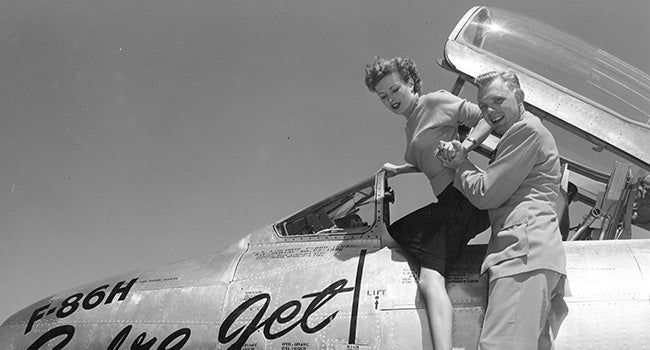Born to fly
Published 10:01 am Thursday, October 20, 2016

- Cassopolis Air Force pilot Iven Kincheloe helps actress Colleen Gray down from a jet used in the filming of the movie “Sabre Jet.” (Photo courtesy of the Dowagiac Area History Museum)
I recently read that the NASA set a goal for sending a manned mission to Mars in the 2030s and entrepreneurs, such as Elon Musk’s SpaceX, hope to send missions to the red planet in the 2020s.
These missions would obviously be very dangerous, but adventurous pilots could certainly be found to take on the missions — as they have since the first flights.
September marked the 60th anniversary of local-boy-made-good Captain Iven C. Kincheloe’s historic flight to the edges of outer space. Test pilots like Kincheloe laid the groundwork for the subsequent astronauts, moon missions, space shuttles and, someday, perhaps trips to Mars.
On the 60th anniversary of his flight, it is worth remembering Captain Kincheloe’s accomplishments. The museum has a great Kincheloe collection with letters, photos, newspaper articles and some personal items.
Born in Detroit in 1928, Kincheloe’s parents moved to rural Cassopolis when he was 3 years old.
Legend has it that a barnstormer used the family farm to land and hooked the young Kincheloe on aviation. He took flight lessons as a young teenager and earned his pilot’s license on his 16th birthday. He attended Dowagiac High School because it offered better math and science classes, which he knew he needed to achieve his goal to become a U.S. Air Force pilot.
Four years at Purdue University studying aeronautical engineering followed his 1945 graduation from DUHS. He also participated in ROTC and participated in flight exercises.
On one of the exercises, he met test pilot Chuck Yeager, who became the first to break the sound barrier in 1947 — this meeting further fueled Kincheloe’s ambitions and gave him the more specific goal of becoming a test pilot.
After graduating from Purdue, Kincheloe enlisted in the U.S. Air Force, which would take him to air battles in the Korean War. Kincheloe was initially assigned to fly escort missions for larger bombers, but he quickly proved his pilot skills and was reassigned to an elite squadron that chased and battled Soviet MiG aircraft.
Flying an F-86E fighter jet named “Ivan,” Kincheloe excelled. He damaged and downed several MiGs early before hitting a dry spell.
His letters show a driven young man. His letter to his parents on Jan. 13, 1952 notes, “Well, I guess I am a little happier now I have had the opportunity to really get behind a little red nosed MiG. I blew him out of the sky. That was my first definite kill.”
On April 1, 1952, Captain Kincheloe had a historic day — according to his letter home, he shot down three MiGs in one day, including two on one mission.
As of his writing to his parents on April 4, one was not yet confirmed and, “Depending on that one and if not will have to try again but might become the Ninth Jet Ace. I was the first one in the 51st [his squadron] to shoot down two MiGs in one mission and the time for this was about 40 seconds.”
He was awarded the Silver Star for this mission as well as two boxes of cigars from his commanding officer, Colonel “Gabby” Gabreski. The delay in confirming the one downed MiG allowed another pilot to be named the Ninth Jet Ace, but Kincheloe received the distinction of being the 10th.
Kincheloe’s tour of duty in Korea ended in May 1952 after 131 combat missions.
Upon his return to the U.S., Captain Kincheloe was lauded as the 10th Jet Ace in newspapers and magazines across the country. Newspaper articles show that the Air Force was not shy about using Kincheloe’s successful career and ‘movie star’ qualities to its benefit.
He served as an advisor to the film, “Sabre Jet,” with the studios and air force sending out publicity shots of Kincheloe with the actress Colleen Gray.
Captain Kincheloe’s goal, however, was to be a test pilot. He was assigned to Nellis Air Force Base in Nevada, where he served as an instructor. This temporarily stalled his dream and frustrated the ambitious pilot.
How would Kincheloe get on track to be the test pilot he wanted to become? I will complete Kincheloe’s story next month.
Steve Arseneau is the director of the Dowagiac Area History Museum. He resides in Niles with his wife, Christina, and children, Theodore and Eleanor.





